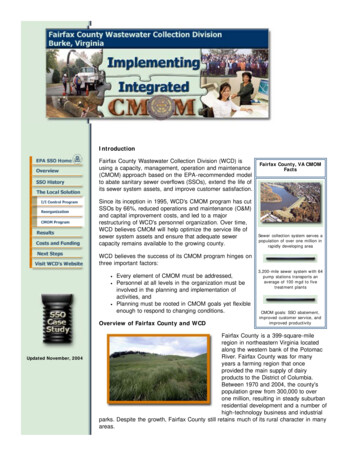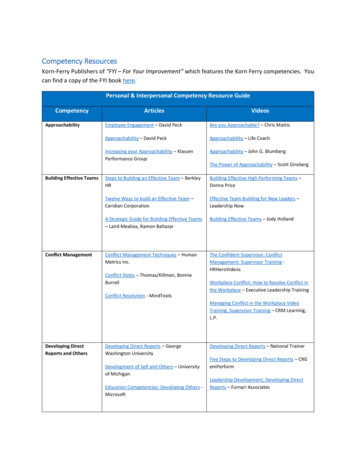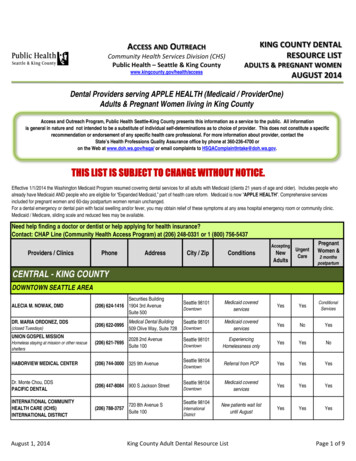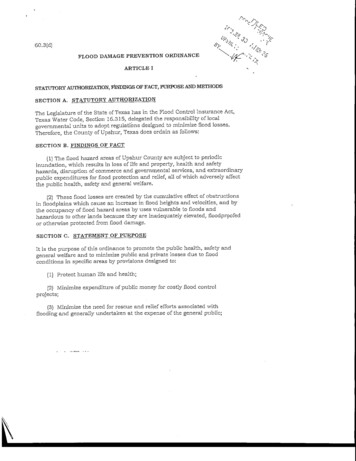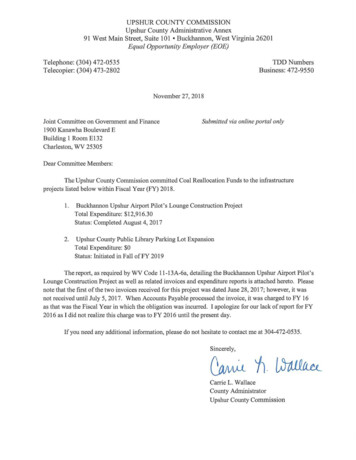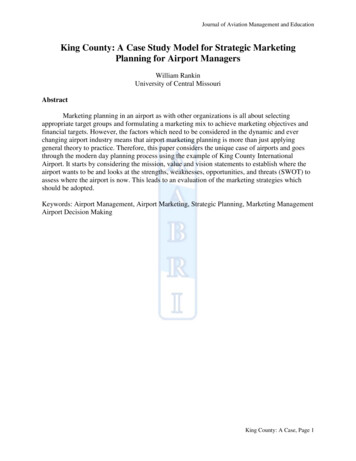
Transcription
Journal of Aviation Management and EducationKing County: A Case Study Model for Strategic MarketingPlanning for Airport ManagersWilliam RankinUniversity of Central MissouriAbstractMarketing planning in an airport as with other organizations is all about selectingappropriate target groups and formulating a marketing mix to achieve marketing objectives andfinancial targets. However, the factors which need to be considered in the dynamic and everchanging airport industry means that airport marketing planning is more than just applyinggeneral theory to practice. Therefore, this paper considers the unique case of airports and goesthrough the modern day planning process using the example of King County InternationalAirport. It starts by considering the mission, value and vision statements to establish where theairport wants to be and looks at the strengths, weaknesses, opportunities, and threats (SWOT) toassess where the airport is now. This leads to an evaluation of the marketing strategies whichshould be adopted.Keywords: Airport Management, Airport Marketing, Strategic Planning, Marketing ManagementAirport Decision MakingKing County: A Case, Page 1
Journal of Aviation Management and EducationIntroductionMarketing planning case studies help airport managers prepare for real-world problems,situations and crises by providing an approximation of various marketing environments. Thus,through the examination of specific marketing cases, airport managers are given the opportunityto work issues through the trials, tribulations, experiences, and research findings of othermarketing professionals. An obvious advantage to this mode of marketing planning is that itallows airport managers the exposure to settings and contexts that they might not otherwiseexperience. One way to study airport marketing issues is through the use of strategic marketingplanning case studies. Strategic marketing planning is a process of developing a map or route anairport will follow which identifies what products are to be provided to which customers, wherethey will be provided, and at what price. Based on the vision and mission statements, an airportstrategic marketing planning summarizes the basic operational tasks, goals, objectives, strategies,and tactics for the airport organization (Quilty, 1999; Pearce and Robinson, 2005).The mission need not be measurable, but it is something the airport employees can worktoward regardless of intermediate achievements. Compared to mission, objectives imply ashorter, measurable time period with an accomplishment that can be measured in numericalterms. For example, an objective might be to achieve 90% hangar utilization within 2 years(Quilty, 1999). A strategy is a major course of action and implies a relatively longer time spanthan tactics. A strategy is what one is going to do and not how the airport is going to do it. Atactic, on the other hand is how the airport is going to achieve the strategy and the ultimate goal.It is a series of shorter action items that are part of the strategy. “Michael Porter, a managementscholar, has identified three classes of competitive advantage strategies. The classes are knownas low-cost producer, differentiation, and focus” (Quilty, 1999, p. 21).The low-cost producer attempts to hold prices low by minimizing costs. These effortsmay take the form of efficient scale of production facilities, product design, distributionchannels, raw materials procurement, etc. Part of this strategy can involve selling in volume sothat low profits per unit may be offset. This strategy is observed in air carriers such asSouthwest Airlines, but it is also practiced in general aviation fuel marketing, at airportsattempting to buy large amounts of chemicals or sand for winter use, and in the air cargo industry(Quilty, 1999).Differentiation strategy involves creating a unique image of the organization’s product orservice so that customers may be charged for that uniqueness. Companies that employ thisstrategy stress high quality, image, or technological leadership, among other possibilities.“Milwaukee International Airport has long stressed its airport as an alternative to Chicago’sO’Hare International Airport, while many general aviation airports stress their ease of use andaccess to important business and commercial centers or recreation areas” (Quilty, 1999, pp. 2122). Differentiation strategy can be viewed between Federal Express and United Parcel Service,and between United Airlines and American Airlines.A focus strategy typically targets a segment of a larger market and specializes in aparticular geographic location or customer group. The focused approach attempts to serve thetargeted needs so well that competitors are left with no opening to gain market share. Anexample is a fixed base operator (FBO) that specializes in specialized maintenance to the pointwhere other FBOs in the area would not find it feasible to establish such a service (Quilty, 1999;Pearce and Robinson, 2005).The concept of competitive advantage causes airport managers to focus on meeting andKing County: A Case, Page 2
Journal of Aviation Management and Educationanticipating the expectations of airport customers by comparing their airport’s performance toother airports or to other transportation modes. It requires an understanding of the competition’sstrengths and weaknesses through and benchmark analysis. It can also be used to assess howrelated businesses located on the airport may respond or pursue their business activity (Quilty,1999; Pearce and Robinson, 2005).In addition to pursuing competitive advantage, an airport may attempt to occupy a specialniche in the environment that is unique to its capabilities, or which offers an opportunityoverlooked by competitors. The strategy in this case is to occupy the niche and then erectbarriers that prevent other organizations from challenging the unique position. Airlines andairport service companies often attempt to use this strategy (Quilty, 1999; Pearce and Robinson,2005).Marketing ObjectivesMarketing objectives are time bound statements of intended future results and generaland continuing statements of intended future results. For purposes of this paper, the marketingobjectives for the King County International Airport (KCIA)* are as follows:1. Identify those elements of the strategic marketing management process thatprecede strategic decision-making at the KCIA.2. Identify and address the products and services that exist at KCIA.3. Identify and address the customers and markets that exist at KCIA.4. Identify and address the competitive advantages of KCIA.5. Identify and address what product and market emphasis KCIA should pursue.6. Identify the strategy or strategies that KCIA should implement and pursue.*Note: KCIA is not the official airport identifier; it is generally only used in promotionalmaterial. The proper identifier is IATA: BFI, ICAO: KBFI.The History of King County International AirportAccording to King County (2004), in 1928 King County voters approved a 1 millionplan to build the region’s first public airport. Today, the airport is one of the busiest airports inthe nation and ranks as one of the most successful public investments in Washington State. Theairport was named after the founder of the Boeing Aircraft Company, William E. Boeing, and theairport helped to foster the growth of the Boeing Company throughout the 1930s. It served as theregional center for commercial and recreational aviation in the Seattle area during this era (KingCounty Airport Division, 2002).Just one day prior to the bombing of Pearl Harbor, the airport was taken over by thefederal government due to its strategic location and its importance as a Boeing production center.During the World War II era, the airport was devoted to the production of the B-17 and the B-29bombers, which played key roles in the European and Pacific theaters. After the war years, theairport served as the primary passenger airport in the region until the construction andcompletion of Sea-Tac International Airport in the early 1950s (King County Airport Division,2002).King County: A Case, Page 3
Journal of Aviation Management and EducationToday, King County International Airport (KCIA) is one of the busiest airports in thenation, serving more than 375,000 aircraft operations per year by recreational, corporate,military, and Boeing jet aircraft. The airport continues to provide limited passenger service and isthe primary air cargo airport in the region. The airport is owned and operated by the King CountyDepartment of Transportation, Airport Division, and receives no general tax revenues to supportits operations. The airport is the site for the final production and delivery of the Boeing 737 and757 aircraft, and a testing center for the Boeing 777 and military AWACS program. SeeAppendix A for the facilities layout of KCIA (King County Airport Division, 2002).Mission, Values, and Vision StatementsThe mission, values, and vision statements of the King County International Airport areas follows:Mission StatementThe mission of the King County International Airport is to support the economic vitalityof the county, to support the national air transportation system, to encourage advancedtechnology, to provide safe and continuous general aviation airport services to KingCounty businesses and residents and to serve as the gateway to the county. In fulfillingthis mission, the Airport will be a good neighbor and environmental steward and willprovide quality facilities to Airport tenants and operators in an efficient, environmentallysafe and fiscally prudent manner. (King County Airport Division, 2002, p.1)Values StatementThe values of KCIA are:1. Safety is crucial2. Economic vitality, responsiveness to the area economy3. Looking to the future4. Environmentally sound5. Collaborative in community6. Innovative7. National leader8. Support state-of-the-art manufacturing (King County Airport Division, 2002, p.1)Vision StatementBy the year 2018, the King County International Airport will be a national leaderdeveloping partnerships with the King County community, businesses and residents toprovide airport facilities and services which are environmentally and economically soundand ensure the community’s well being. Today:1. KCIA strives to be the best airport in the country and serves its aviation customerswell.2. KCIA strives for excellent relationships with the community. There will bemutual respect between the airport and the community, even when the communitydoes not like the impacts of airport operations.King County: A Case, Page 4
Journal of Aviation Management and Education3. KCIA strives to be an excellent County agency, highly regarded by Countyofficials (elected and appointed) as being reliable, efficient, effective, andresponsive.4. KCIA is a great place to work. Employees are valued, recognized, trained andhave a great time. (King County Airport Division, 2002, p.1)Problem StatementTo achieve the mission, values and vision of King County International Airport, theCounty must adopt a sound strategic marketing management plan and implement specificstrategies for success. What are the appropriate strategies to implement? In strategic marketingmanagement, one way to assess the airport marketing environment is through strengths,weaknesses, opportunities, and threats (SWOT) analysis.Strengths Weaknesses Opportunities and Threats AnalysisAccording to Pearce and Robinson (2000), SWOT is an acronym for the strengths andweaknesses of an organization and the environmental opportunities and threats that anorganization faces. The analysis is based on the assumption that an effective strategy evolvesfrom a sound fit between the organization’s internal resources and the organization’s externalrealities, or situation, as follows:1. A strength is a resource advantage relative to its position or situation and theneeds of the community it serves.2. A weakness is a limitation or deficiency in one or more of the organization’srealities or situation that impedes it full potential or effectiveness.3. An opportunity is a major favorable reality in the organization’s environment.Key trends, for example, are one source of opportunities.4. A threat is a major unfavorable reality in an organization’s environment. Threatsare impediments to the organization’s desired reality or position. (pp. 191-221)SWOT analyses are used in many ways to aid strategy makers. One of the most commonways is to use it as a framework to guide systematic development of the organization’s resourcesbased on the alternatives available to the organization. SWOT analyses are a framework ofchoice among many strategy makers because of its simplicity of sound strategy formulation –matching an organization’s opportunities and threats with its strengths and weaknesses (Pearceand Robinson, 2005).KCIA SWOT AnalysisReview of the Airport Manager Candidate Information Materials from King County(2002), revealed the following SWOT analysis:Strengths1. KCIA serves a diverse set of clients, ranging from private pilots to large corporateaircraft operations, as well as government organizations, retailers, wholesalers,and a variety of other services. Boeing Aircraft Company maintains a significantproduction facility at the airport.King County: A Case, Page 5
Journal of Aviation Management and Education2. KCIA generates more than 10,000 jobs in the County and is responsible for 1.6billion in sales by airport tenants. The airport supports the earning of 0.5 billionin labor income per year. Finally, 39 million in state and local taxes aregenerated by the airport each year.3. With approximately 150 businesses based at KCIA, including air cargocompanies, flight schools, charter operations, and helicopter operations, mostbusiness activity at KCIA is sold outside the county economy. Approximately82% of the gross volumes of sales at the airport are represented as new money tothe County economy. T
Planning for Airport Managers William Rankin University of Central Missouri Abstract Marketing planning in an airport as with other organizations is all about selecting appropriate target groups and formulating a marketing mix to achieve marketing objectives and financial targets. However, the factors which need to be considered in the dynamic and ever changing airport industry means that .
